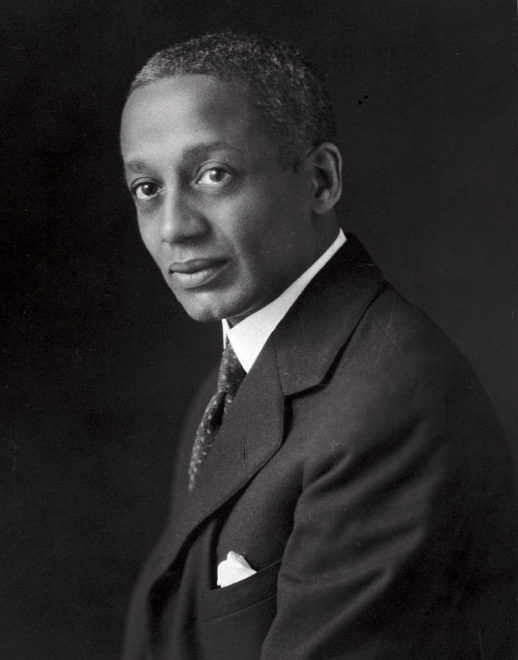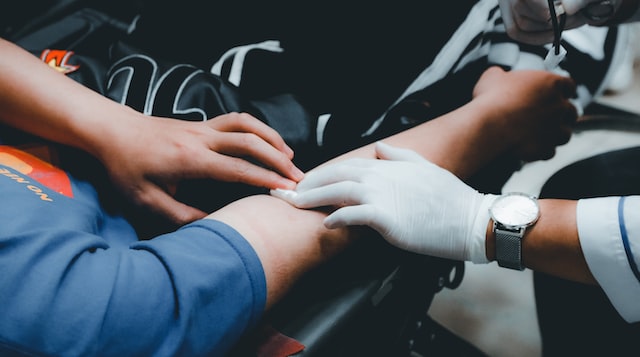
An undated photograph of a young Alain Locke. | Photo courtesy of Moorland-Spingarn Research Center, Howard University
Alain LeRoy Locke had much in common with other prominent 20th century Black men with ties to the Philadelphia area. Like the architect Julian Francis Abele, Locke was dapper, an aesthete, and a member of the African American elite. Similar to the painter Henry Ossawa Tanner, Locke found liberation from pervasive racism when spending time in Europe. Both Locke and singer Paul Robeson have Philadelphia public schools named in their honor in spite of being followed by the FBI due to their openness to communist ideas. Another FBI target with a school named in his honor, West Chester’s Bayard Rustin, had homosexuality in common with Locke.
Although Locke had similarities to these men, he was also one of a kind. As a queer Black man and follower of the Baha’i faith, Locke was a triple minority. At four feet eleven, his stature further marked him as outside of the mainstream. In spite of, or perhaps because of, these challenges, Locke lived a remarkable life, earning the moniker, “Father of the Harlem Renaissance.” Locke, who spent decades teaching at Howard University, may be most closely associated with Washington, D.C. or Harlem. He was, however, a product of Philadelphia.
Locke’s grandfather, Ishmael Locke, was the first principal of the venerable Institute for Colored Youth, a school that offered a classical education to generations of intellectually gifted Black students, including Octavius Catto, Julian Abele, Locke’s father Pliny Locke, and his mother, Mary Hawkins Locke.
After completing his studies at the Institute, Pliny Locke taught at the school and also at a Freedman’s Bureau school in Tennessee. He later graduated in the first class of Howard University Law School. After being the first Black person to take and pass the federal civil service exam, he became the first African American to work for the U.S. Postal Service. In spite of his intelligence and credentials, Pliny Locke’s career path was constrained by his skin color. There was little demand for Black teachers or attorneys.

The Institute for Colored Youth opened at opened at 716-718 Lombard Street opened in 1852. A second, bigger school at 915 Bainbridge Street, pictured here, opened in 1866. The building was placed on the National Register of Historic Places in 1986 and was repurposed for apartments. | Photo: Public Domain
After a 16-year engagement, Pliny and Mary were married in 1879. They, along with their mothers, lived on 19th Street near Addison Street, a neighborhood that housed members of Philadelphia’s Black elite. Arthur LeRoy Locke was born in 1885. He changed his name to Alain as a teenager. Pliny took a job as a night janitor so that he could spend his days with their son. While Pliny was home reading Virgil and Homer to the boy, Mary taught at an all-Black school in Camden. Along with both of Locke’s grandmothers, the family moved to 6th and Tasker Streets in South Philadelphia in 1890.
The following year, when Locke was just six years old, Pliny died. Before his death, he had already become frustrated with his son’s effeminate tendencies. Pliny’s passing only strengthened Locke’s bond to his mother.
Mary’s commitment to education and culture had a powerful influence on her son. Together they took advantage of Philadelphia’s many integrated cultural institutions. They attended concerts at the Academy of Music, heard Greek myths read aloud at the Free Library of Philadelphia, took in exhibits at the Pennsylvania Academy of Fine Arts, learned about science at the Franklin Institute, and went to lectures at the Ethical Society.
Locke was a studious child who loved to read. At age 13, he was admitted to Central High School, then located on the west side of Broad and Green Streets, today the site of Benjamin Franklin High School and the Science Leadership Academy. When he graduated in 1902 (Class 107 for you Lancers out there), he was ranked 2nd. Locke was first in his class at the Philadelphia School of Pedagogy, a teacher training school for Central grads that he attended for two years.

An early 20th century postcard of Central High School at Broad and Green Streets. | Image: Peter Woodall
Locke realized that his options would be limited if he tried to teach in Philadelphia where Black teachers could only teach Black students. Integrated schools such as Central hired only white teachers. Locke left Philadelphia to study philosophy at Harvard. His closest college friends, all white, were fellow Central grads. His small size finally an advantage, he was the first Black coxswain for the Harvard rowing team.
Continuing to excel academically, Locke graduated magna cum laude and Phi Beta Kappa from Harvard in 1907. He became the first Black Rhodes Scholar, gaining the opportunity to study at Oxford University. There was not another African American Rhodes Scholar until 1963 when the author John Edgar Wideman won the prestigious award.
After three years at Oxford, Locke studied an additional two years at the University of Berlin, reveling in the more open social and sexual atmosphere of this cosmopolitan city. When he returned to the United States, Locke taught at Howard University and later completed his doctorate in philosophy at Harvard. He returned to Howard, but was dismissed for three years in the mid-1920s after advocating for pay equity between white and Black professors.
It was during this hiatus from teaching that Locke moved to New York and authored his most famous work. The New Negro: An Interpretation, an anthology of poems, essays, drawings, musical pieces, stories, and music by Black artists, made Locke a national figure. He was able to explain the flowering of the arts then taking place in Harlem to both whites and African Americans. Locke believed that Black people had a special ability to draw on their pasts to create personal works of art that conveyed universal themes. He became the preeminent authority on African American culture and promoted the works he found most worthy. Langston Hughes, Countee Cullen, Claude McKay, Jean Toomer, and Zora Neale Hurston are among the many Black creatives who were mentored, and sometimes courted, by Locke.

1927 dustjacket of Alain Locke’s groundbreaking anthology, The New Negro: An Interpretation. | Image: Public Domain
In 1928, Locke was lured back to Howard by the university’s first Black president. He stayed at Howard as chair of the Philosophy Department until 1953. Actor Ossie Davis was among the many students with whom Locke developed a close bond. By the time Locke died in 1954, he was a world-renowned scholar, writer, speaker, editor, and critic.
Once Locke headed to Harvard, Philadelphia was never again his primary residence. Indeed, when he first arrived in Cambridge and was seeking a place to board, he wrote to his mother that “If I could get a nice bunk up here, Phila would never see me again.” However, even after Mary moved to Washington, D.C. to be closer to her son, Locke continued to visit the city of his birth.
Side note: Although Mary Locke was delighted to be living near Alain, she missed shopping at Wanamaker’s. Blacks were banned from Garfinkel’s, the leading department store in Washington, D.C.

A portrait of Alain Locke by artist Winold Reiss from 1925. | Image courtesy of The National Portrait Gallery, Smithsonian Institution
In 1924, Locke was summoned to the Merion estate of Albert Barnes, another Central grad, although one who had graduated at the bottom of the 92nd class. The two had met in Paris and shared a passion for African art, albeit for different reasons. While Barnes saw African art as the inspiration for his beloved European modernism, Locke hoped it could provide a source of pride and motivation for African American artists. Both Barnes and Locke were known for their exceptional taste and their outsize egos. Not surprisingly, they had a falling out. Barnes accused Locke of plagiarizing his ideas, and their brief connection was forever ruptured.
But his ties to Philadelphia continued. Locke authored a brief introduction for the first edition of the Black Opals, a series of pamphlets written for Philadelphia’s Black public school students. In this 1927 piece, “Hail Philadelphia,” Locke celebrates with obvious pride his hometown as a place where “the tradition of breeding and respectability in the race lingers in the old Negro families of the city.” As the originator of the term “New Negro,” he also exhorts Philadelphia youth to engage in “vital creative thinking” and to avoid “self complacency and snugness.” The essay concludes: “I want to sing a ‘Hail Philadelphia’ that is less a chant for the dead and more a song for the living. For especially for the Negro, I believe in the ‘life to come.’”
In the early 1940s, after decades of heartbreak, Locke found love in his native city. Maurice Russell was 40 years Locke’s junior, but the affection and attraction between the men seems to have been mutual. Russell had a civil service job at the Philadelphia Naval Yard, yet Locke impressed upon him the importance of education, writing to him that “Training is imperative for everyone nowadays, particularly for the younger Negro. Philadelphia youth haven’t seemed to realize this as realistically as they should. The town is full of nice, untrained, but complacent people.”
Russell sent Locke the 1942 summer schedule for Philadelphia Orchestra concerts at the Robin Hood Dell. Locke expressed particular interest in attending performances by two Black singers: Philadelphia native Marian Anderson and future Philadelphia resident Paul Robeson.
Locke traveled the world, but Philadelphia was his birthplace and the city in which he came of age. Although five American schools have been named for him, the Alain Locke School at 46th Street and Haverford Avenue was the first. The school opened without controversy in 1965. At that point, his homosexuality was virtually unknown to the public. In contrast, the school board of West Chester, Pennsylvania briefly rescinded their decision to name a high school for Bayard Rustin in 2002 when community members objected to honoring a gay man in this way, particularly one who had associations with communism.
In 1991, a historical marker was installed in front of 2221 S. 5th Street, the home purchased by Mary Locke following her husband’s death. She and Alain lived in this two-story row house between Jackson and Wolf from 1892 to 1899. Research conducted recently by Jefferson University architecture student Brent Cook reveals that once Mary sold the home, it was purchased eight more times—mostly by people with Jewish or Italian last names. The current residents are Cambodian.

London-based artist Ben Slow painted this mural of Alain Locke at Juniper and Cypress Streets in 2018. | Photo: Michael Bixler
Unfortunately, the historical marker is no longer standing. According to a representative of the Pennsylvania Historical and Museum Commission, “It was continually hit by vehicles on the narrow streets of South Philadelphia.” Equality Forum director Malcolm Lazin has led an effort to erect a new marker honoring Locke, this time in front of the African American Museum of Philadelphia. An installation ceremony is scheduled for 11:30 AM on Sunday, October 3, 2021. The event will be open to the public.
Like many gay men in his generation, Locke lived in the closet in an atmosphere Lazin describes as a “tsunami of homophobia.” Locke is celebrated today, however, as a gay icon. In 2018, a mural of Locke was painted at Juniper and Spruce Streets, the heart of the Gayborhood—a fitting honor for a noteworthy native son.








